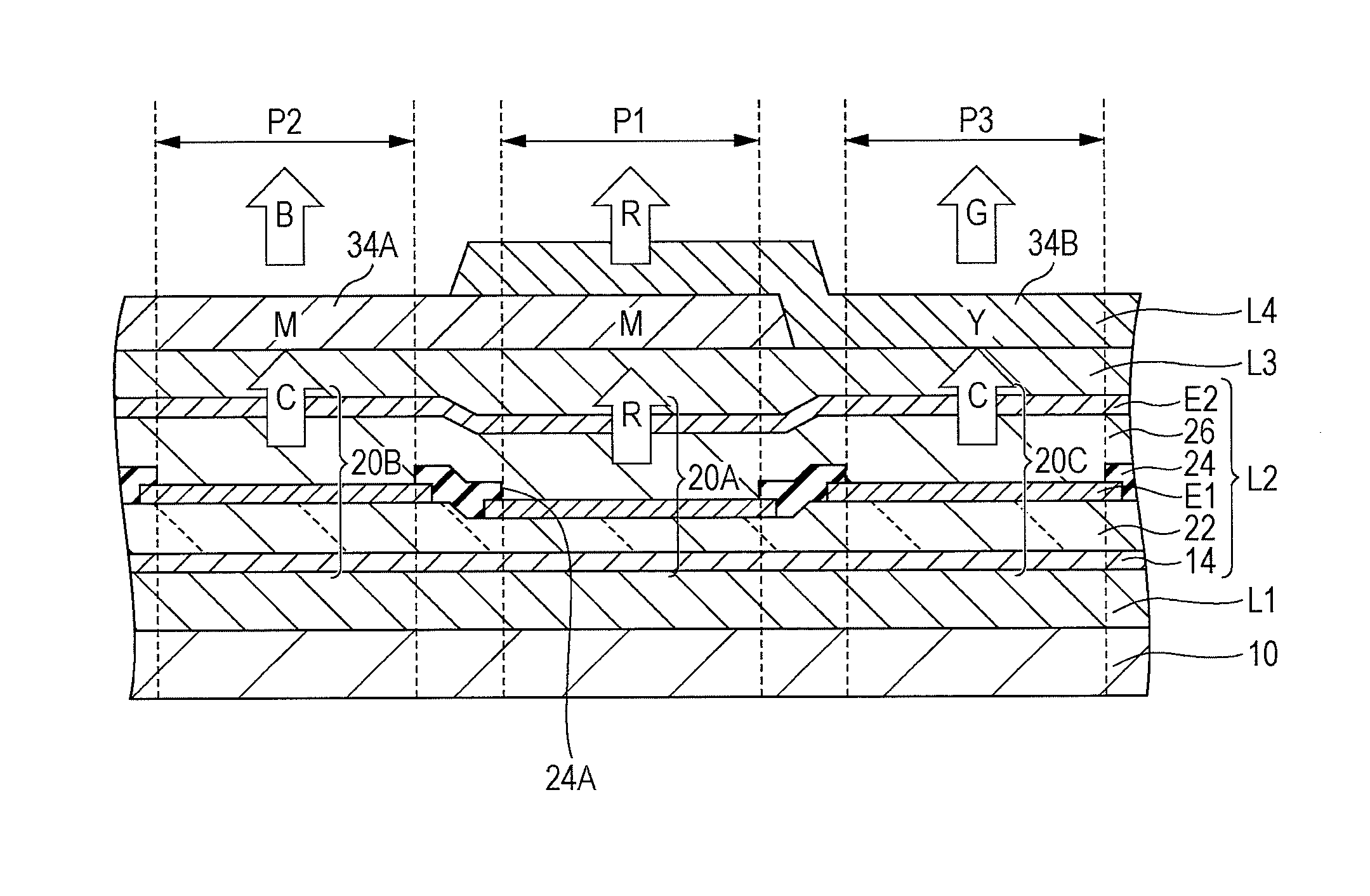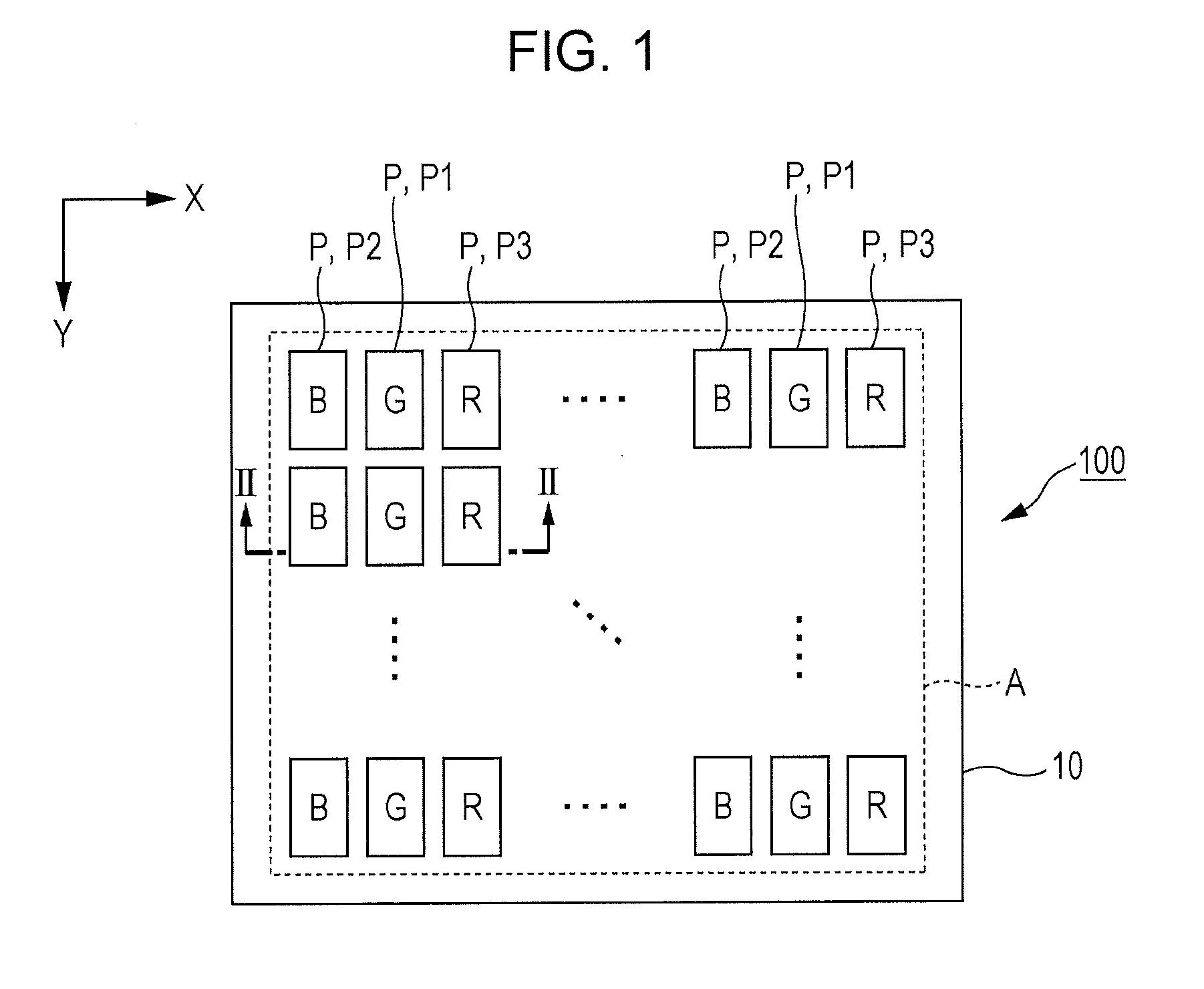Light-emitting device and electronic apparatus
a technology of light-emitting devices and electronic devices, which is applied in the field of image display techniques, can solve the problems of difficult to obtain a sufficient amount of light transmitted through the first color filter, and complicated formation process of color filters and and achieve the effect of simplifying the formation process of color filters and the structure of light-emitting devices
- Summary
- Abstract
- Description
- Claims
- Application Information
AI Technical Summary
Benefits of technology
Problems solved by technology
Method used
Image
Examples
embodiment 1
[0032]FIG. 1 is a plan view illustrating a light-emitting device 100 according to Embodiment 1 of the invention. The light-emitting device 100 according to Embodiment 1 is an organic EL device in which a light-emitting element including an organic EL material is formed on a substrate 10. The light-emitting device 100 includes a display region A in which a plurality of pixels (sub-pixels) P are arranged in matrix along an X-direction and Y-direction which intersect with each other. The pixels P in the display region A include three types of pixels P (P1, P2, and P3) for different display colors. Specifically, a pixel P1 emits light of a medium wavelength range which corresponds to a green (G) color, a pixel P2 emits light of a short wavelength range which corresponds to a blue (B) color, and a pixel P3 emits light of a long wavelength range which corresponds to a red (R) color. The pixel P1, the pixel P2, and the pixel P3 form one dot of a display image. A drive circuit (not illustra...
embodiment 2
[0054]Embodiment 2 of the invention is now described. In Embodiment 1, emission light from the second light-emitting element 20B and the third light-emitting element 20C are generated by a resonance structure in which resonance of a resonance wavelength in the second wavelength range Q2 and resonance of a resonance wavelength in the third wavelength range Q3 occur in parallel. In Embodiment 2, light with a spectrum having a single peak covering the second wavelength range Q2 and the third wavelength range Q3 is emitted from the second light-emitting element 20B and the third light-emitting element 20C. Note that in the following examples, with regard to elements having a similar effect or function to those of Embodiments 1, reference numerals in Embodiment 1 are used and detailed description of such elements is omitted as appropriate.
[0055]FIG. 5 is a cross-sectional view of the light-emitting device 100 according to Embodiment 2. FIG. 6 illustrates spectral characteristics of light...
modification example a
[0067]FIG. 8 is a cross-sectional view of the light-emitting device 100 according to Modification Example A. As illustrated in a plan view of FIG. 8, a partition 36 is formed between the first color filter 34A and the second color filter 34B, in a region between the pixel P2 and the pixel P3. In a structure of FIG. 8, the partition 36 separates the first color filter 34A and the second color filter 34B between the pixel P2 and the pixel P3, whereby overlapping of the first color filter 34A and the third light-emitting element 20C and overlapping of the second color filter 34B and the second light-emitting element 20B can be prevented.
PUM
 Login to View More
Login to View More Abstract
Description
Claims
Application Information
 Login to View More
Login to View More - R&D
- Intellectual Property
- Life Sciences
- Materials
- Tech Scout
- Unparalleled Data Quality
- Higher Quality Content
- 60% Fewer Hallucinations
Browse by: Latest US Patents, China's latest patents, Technical Efficacy Thesaurus, Application Domain, Technology Topic, Popular Technical Reports.
© 2025 PatSnap. All rights reserved.Legal|Privacy policy|Modern Slavery Act Transparency Statement|Sitemap|About US| Contact US: help@patsnap.com



